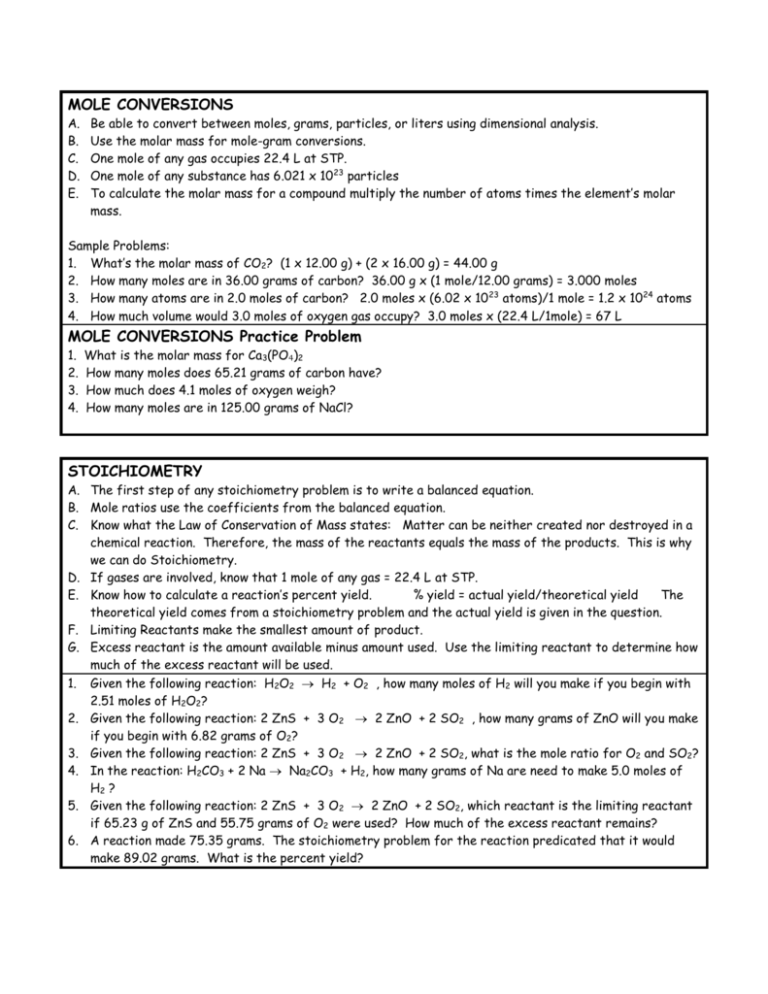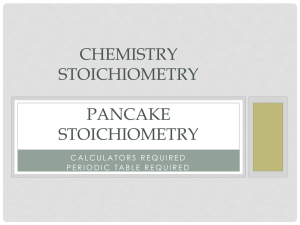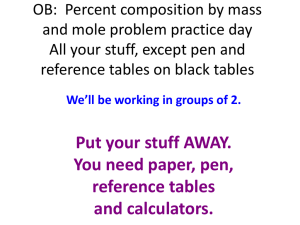unit 5
advertisement

MOLE CONVERSIONS A. B. C. D. E. Be able to convert between moles, grams, particles, or liters using dimensional analysis. Use the molar mass for mole-gram conversions. One mole of any gas occupies 22.4 L at STP. One mole of any substance has 6.021 x 1023 particles To calculate the molar mass for a compound multiply the number of atoms times the element’s molar mass. Sample Problems: 1. What’s the molar mass of CO2? (1 x 12.00 g) + (2 x 16.00 g) = 44.00 g 2. How many moles are in 36.00 grams of carbon? 36.00 g x (1 mole/12.00 grams) = 3.000 moles 3. How many atoms are in 2.0 moles of carbon? 2.0 moles x (6.02 x 10 23 atoms)/1 mole = 1.2 x 1024 atoms 4. How much volume would 3.0 moles of oxygen gas occupy? 3.0 moles x (22.4 L/1mole) = 67 L MOLE CONVERSIONS Practice Problem 1. 2. 3. 4. What is the molar mass for Ca3(PO4)2 How many moles does 65.21 grams of carbon have? How much does 4.1 moles of oxygen weigh? How many moles are in 125.00 grams of NaCl? STOICHIOMETRY A. The first step of any stoichiometry problem is to write a balanced equation. B. Mole ratios use the coefficients from the balanced equation. C. Know what the Law of Conservation of Mass states: Matter can be neither created nor destroyed in a chemical reaction. Therefore, the mass of the reactants equals the mass of the products. This is why we can do Stoichiometry. D. If gases are involved, know that 1 mole of any gas = 22.4 L at STP. E. Know how to calculate a reaction’s percent yield. % yield = actual yield/theoretical yield The theoretical yield comes from a stoichiometry problem and the actual yield is given in the question. F. Limiting Reactants make the smallest amount of product. G. Excess reactant is the amount available minus amount used. Use the limiting reactant to determine how much of the excess reactant will be used. 1. Given the following reaction: H2O2 H2 + O2 , how many moles of H2 will you make if you begin with 2.51 moles of H2O2? 2. Given the following reaction: 2 ZnS + 3 O2 2 ZnO + 2 SO2 , how many grams of ZnO will you make if you begin with 6.82 grams of O2? 3. Given the following reaction: 2 ZnS + 3 O2 2 ZnO + 2 SO2, what is the mole ratio for O2 and SO2? 4. In the reaction: H2CO3 + 2 Na Na2CO3 + H2, how many grams of Na are need to make 5.0 moles of H2 ? 5. Given the following reaction: 2 ZnS + 3 O2 2 ZnO + 2 SO2, which reactant is the limiting reactant if 65.23 g of ZnS and 55.75 grams of O2 were used? How much of the excess reactant remains? 6. A reaction made 75.35 grams. The stoichiometry problem for the reaction predicated that it would make 89.02 grams. What is the percent yield? MOLE CONVERSIONS F. G. H. I. J. Be able to convert between moles, grams, particles, or liters using dimensional analysis. Use the molar mass for mole-gram conversions. One mole of any gas occupies 22.4 L at STP. One mole of any substance has 6.021 x 1023 particles To calculate the molar mass for a compound multiply the number of atoms times the element’s molar mass. Sample Problems: 1. What’s the molar mass of CO2? (1 x 12.00 g) + (2 x 16.00 g) = 44.00 g 2. How many moles are in 36.00 grams of carbon? 36.00 g x (1 mole/12.00 grams) = 3.000 moles 3. How many atoms are in 2.0 moles of carbon? 2.0 moles x (6.02 x 10 23 atoms)/1 mole = 1.2 x 1024 atoms 4. How much volume would 3.0 moles of oxygen gas occupy? 3.0 moles x (22.4 L/1mole) = 67 L MOLE CONVERSIONS Practice Problem 1. 2. 3. 4. What is the molar mass for Ca3(PO4)2 How many moles does 65.21 grams of carbon have? How much does 4.1 moles of oxygen weigh? How many moles are in 125.00 grams of NaCl? STOICHIOMETRY H. The first step of any stoichiometry problem is to write a balanced equation. I. Mole ratios use the coefficients from the balanced equation. J. Know what the Law of Conservation of Mass states: Matter can be neither created nor destroyed in a chemical reaction. Therefore, the mass of the reactants equals the mass of the products. This is why we can do Stoichiometry. K. If gases are involved, know that 1 mole of any gas = 22.4 L at STP. L. Know how to calculate a reaction’s percent yield. % yield = actual yield/theoretical yield The theoretical yield comes from a stoichiometry problem and the actual yield is given in the question. M. Limiting Reactants make the smallest amount of product. N. Excess reactant is the amount available minus amount used. Use the limiting reactant to determine how much of the excess reactant will be used. 1. Given the following reaction: H2O2 H2 + O2 , how many moles of H2 will you make if you begin with 2.51 moles of H2O2? 2. Given the following reaction: 2 ZnS + 3 O2 2 ZnO + 2 SO2 , how many grams of ZnO will you make if you begin with 6.82 grams of O2? 3. Given the following reaction: 2 ZnS + 3 O2 2 ZnO + 2 SO2, what is the mole ratio for O2 and SO2? 4. In the reaction: H2CO3 + 2 Na Na2CO3 + H2, how many grams of Na are need to make 5.0 moles of H2 ? 5. Given the following reaction: 2 ZnS + 3 O2 2 ZnO + 2 SO2, which reactant is the limiting reactant if 65.23 g of ZnS and 55.75 grams of O2 were used? How much of the excess reactant remains? 6. A reaction made 75.35 grams. The stoichiometry problem for the reaction predicated that it would make 89.02 grams. What is the percent yield?







